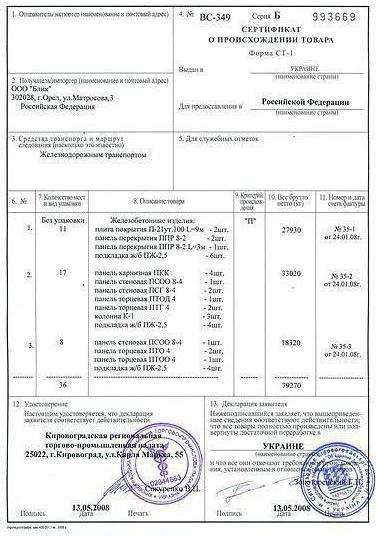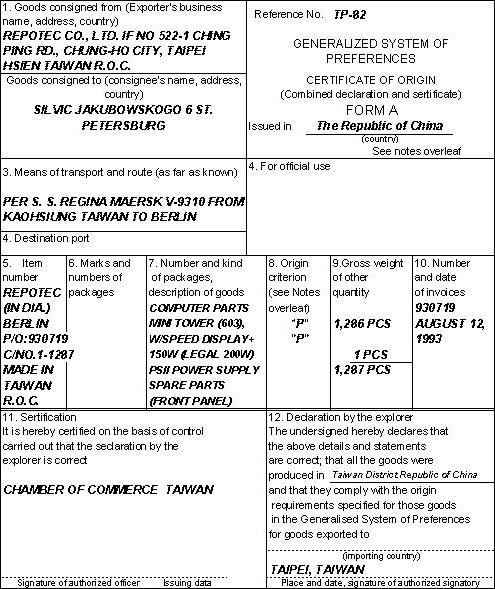Certificate country of origin It is a document unambiguously indicating the state from which this product comes. Let's consider it in more detail. 
Characteristic
The certificate is issued by an authorized body or institution of the country of manufacture or the state from which the goods are exported. In the latter case, the document is compiled in accordance with the information provided by the manufacturer of the product. If the certificate information about the country of origin of goods is based on other criteria than accepted in Russia, these data are determined according to the rules applicable in the Russian Federation.
customs control
In the event of improper issuance of a certificate or the identification of false data, the verifying authority may send a request to the institutions that issued the document with a request to provide clarifying information or additional materials. The customs service has the right to exercise this right, in particular, when:
- The presence of unauthorized corrections, blots, cleanings.
- Lack of necessary stamps or signatures.
- Inability to establish compliance of information in the certificate with the declared goods.
- Ambiguous reference to the state in which the product was manufactured.
A spot check (request for clarification or additional documents) is not an obstacle for the admission of goods in accordance with the information about the country of origin stated in the process of customs clearance. 
Classification
The certificate of origin must be provided simultaneously with the declaration and other documents during customs clearance. The state in which the product was manufactured may enjoy tariff preferences if it is a participant in the relevant scheme. In this case, the certificate will be a certificate of form A. Other states may be parties to the agreement on the formation of the FTZ. In this case, they provide a certificate of origin of goods ST-1 (a sample of this document will be described below).
Design specifics
The provision of customs preferences is allowed if the certificate of origin (form A) is completed in accordance with the rules. If a discrepancy is found to the established order of registration, then apply:
- Rates of import duties determined for products supplied from countries in which the Russian Federation provides for MFN (economic most political relations) (most favored nation treatment). These tariffs will be valid until the results of certificate verification. Such an order is applied if it is possible to establish the state in which the product is created, according to accompanying documents, specifications, quality confirmations. The indicated tariffs are also used if the country of origin is not defined, but there are no signs that MFN is not provided for in its economic and political relations with the Russian Federation.
- The doubled rates of import duties established for products created in the states in which Russia applies the most favored nation treatment in trade interactions. Such tariffs are valid if during the inspection it turns out that there is no MFN with this country. Higher rates will be used until the results of the analysis of documents.

Preferential treatment applied / restored after confirmation by the state in which the product was created, before 1 year from the date of acceptance of the declaration by the customs service.
Certificate of Origin: Form ST-1
As a rule, it is drawn up in relation to each separate delivery of products made by one or several vehicles to one recipient from one sender. When goods are exported from the states participating in the agreement, a certificate of origin of goods of a general form is issued by the competent authority in accordance with the provisions of the exporter's legislation. The document is executed on a secure special form, the format of which is A4. It is made by printing. Certificate of origin of goods (ST-1) is valid for 12 months. from the date of issue. The states participating in the agreement should exchange forms of documents, examples of signatures of persons and seals of authorities authorized to certify them. Without the provision of these samples, certificates will be invalidated. Accordingly, the regime of preferences provided for by agreement will not apply to products.
Certificate of Origin: sample
There are certain requirements for completing this document. They are established in paragraph 12 of the rules approved by the Council of Heads of Government of the CIS countries. The certificate of origin (CT-1) is filled out as follows:
- Column 1. It indicates the name and postal address of the sender / exporter. This line may include information from the certificate of state registration of the company. If the exporter and the sender are different organizations, it is necessary to indicate that the former acts in accordance with the “instruction” of the latter.
- Column 2. It indicates the name and address of the recipient / importer. If they are different entities, as in the first line, it must be indicated that the first acts on behalf of the second.
- Column 3. This line indicates the route and vehicles (as far as this information is available to the designer).
- Column 4. It indicates: the number of the document, the name of the state that issued this certificate of origin of goods and for which it is intended.
- Column 5. This line contains the official marks of the state control services of the countries of transit / receipt, export of goods. If necessary, additional information may be indicated: "Duplicate", "Issued subsequently" and so on.
- Column 6. It shall bear the product number.
- Line 7 shall indicate the type of packaging and the number of places.
- Column 8. It gives a brief description of the product: its commercial name and other information that can be used to uniquely identify the products and compare with the one declared for registration.
If there is not enough space on the front side of the document to fill in any column, additional sheets are allowed. Entries on the back of the form are not allowed. Additional sheets are drawn up in the prescribed manner. They must have the same serial number as the certificate of origin. Sheets are certified by signature and seal.

Line 9
It indicates one of the criteria of origin:
- "P" - products fully manufactured in the state participating in the agreement.
- "D" - products subjected to sufficient processing / processing. At the same time, the first 4 digits of the position code are indicated in accordance with the HS of the CIS.
If the certificate claims products that are classified by different positions and have different criteria of origin, in column 9 signs are indicated differentially for all objects.
Important point
If, during customs clearance, a certificate of origin of goods is provided, column 9 of which contains a four-digit HS code, which differs from the first 4 digits of the code indicated in line 33 of the cargo customs declaration, the paperwork will be considered inconsistent with the requirements of the rules. These forms will not be considered as the basis for the provision of preferences.

Counts 10-13
In 2004, the CIS Council adopted a number of changes that affected the filling. The adjustments for line 9 are indicated above.As for graph 10-13, the following design is accepted:
- Line 10. In this column are weighted or quantitative characteristics of the products. The difference between actual indicators and information in the document should not be more than 5%.
- Line 11. In it indicate information on the proforma invoice, invoice or other document that reflects financial and quantitative indicators for the product. Filling this line when implementing long-term contracts, under the terms of which the goods are transported by rail from one consignor to one recipient, is not necessary.
- Box 12. It is filled in by the competent authority and contains its name, address, seal, number of certification information provided in the document. Signature, surname, initials of the person authorized for certification are also placed here.
- Box 13. It sets out the state in which the product was completely manufactured or subjected to sufficient processing / processing. The same line shall indicate the date of declaring the data, put the signature and seal of the applicant, last name, initials of his authorized representative.

Additionally
If products are imported / exported by an individual who is a resident of one of the states participating in the agreement, the certificate must be completed taking into account a number of features:
- Column 1. It indicates the name and address of the sender.
- Column 2. It contains the name and address of the recipient, as well as the mark "For free circulation".
- Columns 5 and 11 in the absence of information may not be completed.
- Line 13. Information must be certified by the signature of the sender indicating his name, as well as the date of execution.
If a certificate is lost or damaged, a duplicate is issued. It must be officially certified. When issuing, column 12 is the date, and line 5 indicates “Duplicate”, as well as the number of submission and the number of the lost original. The repeated document begins to operate from the date of issue of the first. The total validity period of the original and duplicate cannot be more than 12 months.








